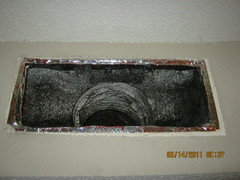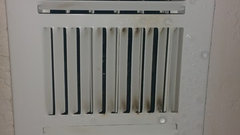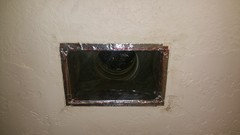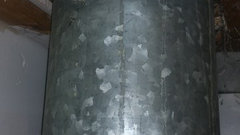Ac vents sweating
Now that we're getting into the nice Texas heat I noticed a few ac vents had condensation on them. I went into the attic and the ductwork doesn't have any condensation on them the I'm guessing condensing unit, a box with the drain pipe coming out of it, has some condensation on it but it seems the be the least insulated thing up there. I wanted to see if there was any sweat or mold on the inside of the ducts so I took the grille off the register vent and it was dry as a bone inside and no mold of evidence it had been wet.
Someone suggested the ac unit could be to small but the previous owner had it put in less that 10 years ago so I figured surely he wouldn't have undersized it and when I checked the outside unit it's a model number hs26-048-5p which I belive is a 4 ton unit. All the charts I looked at said it's oversized for my just above 2000 sq ft house with all 8 ft ceilings. The siding, windows, and insulation on the exterior of the home were all replaced last year so I figured it would give the ac a break but it seems like it's running more now then ever.
I have a guy coming over this weekend to clean and service the unit and see if it's low on freon. But I'm curious if anyone has had this problem before and what they did to solve it.
Comentarios (36)
nirvanamike06
Autor originalhace 7 añosI do try to change the filter out every 30 days and I buy the 30 day filters because I read the longer lasting ones choke down airflow. If I need to increase the airflow how would I go about doing that? I'll ask my ac guy if I need more airflow. I have one air intake and it's a 20x15 I believe.
ionized_gw
hace 7 añosHumid where you live? How are the temperature and humidity inside your home? Does the compressor cycle much? Replacing siding, insulation and windows should help your your house a lot, but if installed improperly and allowing lots of air leakage, it could have been a wash. Lots of AC load is to condense water in humid climates.
How is the duct leakage rate? When you wrote that there is condensation on the vents, you mean on the grates? Check the boots around the vents. Are there leaks to exterior space there?
nirvanamike06 agradeció a ionized_gwnirvanamike06
Autor originalhace 7 añosYeah it's extremely humid. I'm just east of Houston on the Gulf coast. The temp's outside have been around 95+ heat index around 102 lately. I have the ac set on 75 and it sweats and never cycles off i put it on 80 and it cycles and stops sweating but 80 seems pretty warm. This is when I get home so the temp has probably started coming down some.
Yea only the grates are sweating and the condensing unit.
I know the windows do better than the old ones when it would be heavy wind outside I could feel the wind cutting through the windows if I stood in front of them. And the old windows used to get a lot of condensation on them and I'd have water stains around the frames.ionized_gw
hace 7 añosSometimes people are very disappointed with new windows. The installers all too often do not install them properly resulting in a lot of air passing around them.
Get a couple of thermometer/hygrometers and set them up inside to monitor your humidity level. I suggest two so you can check for continuing agreement. If one goes off, you know they are not working. Alternatively, you could get a sling psychrometer on ebay.
There is no problem with constant running and that will result in lower humidity than cycling. Check your boots around the cold vents. Look into local programs that will pay for, or help defray the costs of an energy evaluation of your house including checking duct leakage.
nirvanamike06 agradeció a ionized_gwenergy_rater_la
hace 7 añosWe have had a lot of rain. if this is a reoccurring issue you should seal the supply
box to the ceiling. by eliminating the gap between the sheetrock
ceiling & the supply box, you will stop condensation on the grills.
I use Hardcast brand 1402 mastic tape. I've tried other tapes...
but this one is the one that lasts long term.
here is how I stop the condensation:

best of lucknirvanamike06 agradeció a energy_rater_lanirvanamike06
Autor originalhace 7 añosThanks. I'll try that. Is that hardcase mastic something they sell at lowes?
I was wondering if I got in the attic and pulled the insulation back from around the box and used the great stuff foam sealant and made a bead around the whole box and the back of the drywall it would do the same thing? There is only 4 vent's in the whole house that sweat.- nirvanamike06 agradeció a ionized_gw
nirvanamike06
Autor originalhace 7 añosOK the ac guy just left. The coils in the attic were sweating because the insulation inside the box had come unglued and fell down letting the attic air get to it. That's solved. The coils were extremely dirty but they were cleaned up and he said there was a small streak on the coils that will eventually turn into a leak and the system was 2lbs low but in his opinion he'd just charge it up and hope it lasts another year or 2.
As far as the vents he said he thinks it's because of the high humidity and high temperatures we've had but all my grates are metal and he recommended changing them to plastic since there was no condensation inside the boxes. I think I'll try and get some tape and change them out to plastic and use the mastic tape like energy rater suggested.
The one thing that makes me question everything he said was my outside unit is a 4 ton and the upstairs unit he said was a 5 ton. He said he would upgrade the outside unit to a 5 ton when the time comes. My house is just a little over 2000 Sqft with 8ft ceilings throughout it was built in 1980 though. My friend at work just had his ac replaced and his 3200 sq ft house with some vaulted ceilings was built in the mid 90s and he said they put a 5 ton unit for his house.alabamatreehugger 8b SW Alabama
hace 7 añosOversizing the unit will just make it short cycle and the humidity problem will get worse.
nirvanamike06 agradeció a alabamatreehugger 8b SW Alabamapete peters
hace 7 añosThe temperature of the register is below the dewpoint of the air in the room. Supply could be too cold ( too low cfm ? ) and/or excess humidity .
nirvanamike06
Autor originalhace 7 añosWell I don't know if humidity is the issue. When it gets dark outside I turn the temp way down and it doesn't condensate at all. But it's still humid as heck outside.
How would i check cfm? The ac guy that came out said to leave the fan on instead of auto and it might help it dry out and it did seem like it helped some but I didnt have a chance to test it through a whole day yet and i don't want the fan to run 24/7.
My plan this afternoon is I'm buying some hardcast 1402 tape and seal the vents. Buy 2 hygrometer's and just measure the humidity levels. And I'm gonna put 1 plastic grate on and see if that vent stops sweating.
Anything else I should try?dadoes
hace 7 añosBlower running continuously will typically increase indoor humidity. Collected moisture remaining on the evaporator coil when the compressor cycles off (assuming it does) will be blown back into the house when the blower keeps running. Assuming your ductwork is in your attic and exposed to the high temperatures up there, you may also pick up some attic heat blowing into the house between cycles (air handler and duct insulation isn't all that effective).
Checking CFM requires special test instruments.
energy_rater_la
hace 7 añosyou can't get Hardcast at lowes or hd. call your local hvac supply house.
seal all the supplies.
don't up size the system. the coil was oversized to help control humidity.
if your ducts were properly sealed, the house air sealed & theattic well insulated...you could cool with a 3 ton system.
don't run fan in continuous mode. it just releases the moistureon the coil back into the house.
I'd invest in a different supply grill, like a 3 way adjustable grill.I've never put in plastic supply grills.
seal the gap, that is the important thing.
post your RH numbers.
best of lucknirvanamike06 agradeció a energy_rater_laionized_gw
hace 7 añosHow can the dew point of the air at the grate be higher than at the coil? Outdoor air leaking into the boot and mixing with the conditioned air from the evaporator seems to be the most likely way. The only other way I can see to get the temp of the metal grate below the dew point would have to be that the room humidity is so high that the room air is condensing on the grate between cycles.
I'd leave the metal in place and see what happens when you seal the boots to the walls (or ceiling depending on location). That way you'll have lower expense and the satisfaction of knowing what the fix is rather than changing two variables at the same time. Can you see through spaces around the boots? Sometimes they are attached so poorly that you can.
The only HVAC supply place that I've found that sells to the person on the street is Coburn Supply.
nirvanamike06
Autor originalhace 7 añosÚltima modificación: hace 7 añosI went online to the hardcast site and there's a dealer right down the road from me I think he said $35 a roll. Sounded reasonable.
I guess I'll see if sealing them does anything first before I try a plastic grate. I took a picture of my grate after I got home and the wife had cranked the ac down where it was running coninuously during the day.
there is no moisture or mildew on the sheet rock above or below and none on the metal box the grille screws to. The little stuff on the corner is dust.
I really appreciate all the help.
nirvanamike06
Autor originalhace 7 añosÚltima modificación: hace 7 añosOK I sealed up 3 vents that had condensation on them as a test so far it doesn't look good..... they didn't have a ton of moisture on them but it was already getting later and they don't sweat at night. I went up in the attic and put some spray foam around the bottoms of the metal boxes around the drywall.

I forgot to pick up the dang hygrometer at the store.... there was some on the shelf and I ment to grab 2 but there were a bunch of ac guys in there talking shop and I got nervous when I asked if I should buy the 2 or 3 inch tape to seal the ducts and started feeling like a dummy and forgot all about it.
ionized_gw
hace 7 añosIt is interesting, that they don't condense at night. One would think that humidity increases at night. Did you notice gaps around the boots when you were preparing to work on them? You have a very conventional cooling system? By that I mean single-speed blower and compressor?
nirvanamike06
Autor originalhace 7 añosI thought the same thing. I figured at night since there's dew on the grass there'd be more chance of dew inside.
When I taped them up there was some big gaps but there was a small amount of gray putty in some of the bigger gaps.
I'm not sure about the fan or compressor. I'll look and see what the model number is in the upstairs unit. The unit was installed in 2004 and I know it's a Lennox elite series. I'm hoping when I get home it'll be condensation free but I'm not getting my hopes up.ionized_gw
hace 7 añosIn fact, the absolute humidity outside stays pretty much the same over the course of a day if there is not a front moving through or some other meteorological disturbance. The relative humidity increases with the decrease in temp. The temperature dips to and below the dew point and you get.... dew.
Inside, if things just locked up and did not change, temp, air, the RH would stay the same, but you have leaks to the outside and living produces water vapor (breathing, transpiration from skin, cooking, cleaning, showering,...) Here is the key factor in indoor night time humidity increases. The heat load is lower so the AC runs less (cycles more) so you get less humidity removal unless you have a variable speed system that can adjust itself for more humidity removal by running the coil more constantly cold and moving the air slower. Those systems don't always keep the humidity low, but they do make a big difference.
nirvanamike06
Autor originalhace 7 añosI put one of those min and max humidity meters in the room that sweats the most and when I turned it on when I got home it read 55 and when I woke up this morning it was 50. It did climb up to 60 right after I got out of the shower but I think that was from the steam of the shower since I had the door open and the bathroom has a hallway that leads right into the kitchen and mudroom where I'm having the problems. 60 sounds high but 50 doesn't sound bad does it?
energy_rater_la
hace 7 años50% is ideal.
what is happening is that the small gap around the supply box
allows hot attic air to meet the metal of the supply grill.
heat goes to cold.
with the added humidity of all our rains, your attic
...your vented attic...has more humidity in it than usual.
as the air exits the supply box it creates a little Venturi effectat the attic floor. this pulls in attic air & all
the lovely things under the insulation around the
supply box.
now that the gaps are sealed...the condensation
issue should be solved.
sealing penetrations into the attic is always a goodstart.
now drop the cover on that bath fan...the one you should
be running for 20 minutes after showering...and seal
the oversized cut in the ceiling in there...
nice to air seal from within the comfort of your home!
best of lucknirvanamike06
Autor originalhace 7 añosWell so far no good.... I've still got sweating on 3 vents. It is reduced but still there.... my humidity gauge when I come home is around 55 but the max normally is around 63. It says that's high on the gauge. Outside temps are around 95 and if I set the thermostat to 78 there will be a almost unnoticeable amount of condensation but if I set it at 75 it's pretty wet.
The guy who remodeled my bathroom said I should insulate my attic. It's old black insulation. And I'd say maybe 3 inches deep if that and completely gone in some areas where drywall had been patched. He thinks that even sealing the ac vents that there isn't enough insulation to keep the vents from sweating. Anyone agree?nirvanamike06
Autor originalhace 7 añosWell I figure after all the reading I did and never finding an answer I'd chime in on what my fixes were on this.
So only my grates would sweat no moisture at all inside the register box or inside the duct work. I checked many times. I swapped 1 of the metal grates out for plastic and it immediately stopped the sweating while the other 2 continued to drip. I changed out 1 more of the covers and it stopped sweating so I still have 1 I left so I can try and figure out what is causing the problem. I tried closing doors and blocking off hallways to see if i,could isolate a problem but nothing helped. In fact when I blocked off rooms and put the humidity gauge in them the humidity would drop. I went to Lowes and bought a ton of insulation to try and get my attic up to snuff and while I was there I picked up an infrared thermometer. I went around all the vents and the kitchen and surrounding rooms trying to find the problem with the thermometer in scan mode when I noticed the cabinets above the oven were 85-90 degrees when I opened them up I could smell attic scent and instantly feel a blast of warm air. I looked inside and the vent flue had no insulation of any kind around it and a big square hole cut letting all the hot humid attic air it could handle inside the kitchen. I stuffed a bunch of insulation down around it and hopefully that will solve the issue permanently.
ionized_gw
hace 7 añosGood work so far. I'd look for a better sealer than insulation for the long run. It is not particularly good for air sealing. It is hard to tell what to do with a pick, but I think that I'd try to cut a couple of pieces of drywall with semicircular holes and fit them in around the vent. Seal them with some good adhesive calk.
When a condensation problem like this turns up, you will get answers for the most familiar base problems and their solutions first. If you are lucky, you have a quick fix. If not, you have to dig deeper. Unfortunately, switching out plastic for metal grates does not fix the root problem even though it does keep water from dripping down. Condensation should not be happening and it comes from moist air hitting cold air or cold surfaces. We don't expect moist air at the supply vents, but maybe it is a consequence of how your AC is cycling.
Before you go wild with the added insulation, check the existing for clues to air leaks. Lots of times you will see trails of dust are red flags. Air sealing really needs to be done along with insulation or the insulation will have less of an effect than you predict. Please do your homework with respect to how to add insulation. There are right ways and wrong ways particularly with vapor barriers.
nirvanamike06
Autor originalhace 7 añosYea I was going to put some plywood with 2 half circles cut around it and put a 1x4 across it and screw it together and then use a tube of caulking to seal it and insulate above it and put some of the mastic tape on the inside. I just stuffed the insulation in as a temporary bandaid.
From what Ive read as long as I insulate to r-39 or better I don't need a vapor barrier in my area. I bought enough to do r-39 on top of the 3 inches that's already in there so I should be in the r-45 area. From reading the package and what drywall can support i should be alright on weight. I was planning on trying to seal around any opening in the attic when I use the caulking so I don't waste a lot of it drying up inside of the tube.
What's a good way to seal around the hot water heater flue to the drywall in the ceiling?Patricia Allen
hace 6 añosReduce attic temperature, Try Ridge vents on roof, add more BLOWN insulation around duct work at ceiling register, need plentry of soffit vents, use plastic registers on ceiling only, Home Depot furnishes blower with purchase of insulation material, can do it yourself, all this has been my solution to same problem. Electric vents #1 fire hazard. I used indoor/outdoor thermometer to know attic temp. Planning to add smoke and fire detectors bc dryer vents and electrical wires cause many fire's according to my insurance adjuster neighbor. Hope this helps. Remember to Google anything. I had same problem, this worked for me.
udarrell
hace 6 años[quote]do try to change the filter out every 30 days and I buy the 30 day filters because I read the longer lasting ones choke down airflow. If I need to increase the airflow how would I go about doing that? I'll ask my ac guy if I need more airflow. I have one air intake and it's a 20x15 I believe.[/quote]
What size is the RA Filter? Best 1" deep filter is Purolator P312; search it on the Internet.
The RA intake grille is too small & may not be open enough...
Vith
hace 6 añosÚltima modificación: hace 6 añosInsulation alone doesnt stop air travel. Need to seal that completely open area. My house had many penetrations like this and I sealed them with foam or caulk. Larger gaps with foam. All the electric boxes in the attic (for the main floor ceiling) also had to be sealed, pretty much just foamed over them. I had a bulkhead above the kitchen cabinets with a drain vent penetration completely open, caulked that, um what else, oh yes the freakin furnace and WH flue was completely open as well, no fireblock even. So I had lots of holes into the attic, probably why previous owner sold cause it was hard to heat the house I am sure. Well use some common sense and seal things up.... maybe it will work better.
I put in a ridge vent and more soffit intakes as well to help cool the attic.
I would say dont stop looking for stupid stuff in your house (like the completely open penetration you found), cause usually you will find an abundance.
Coe Plumbing Inc
hace 6 añosDepending on how well the house is insulated, your unit may in fact be under sized. Sizing is normally 400 sq ft per ton of cooling. 2000 devided by 400 is 5. So, unless your house has very good insulation a 4 ton is to small. In new construction you can use smaller units because they are tighter and are insulated much better. On another note, opening and closing outside doors in the summer will make grill condensate.
udarrell
hace 6 añosYou need a lot of unrestricted airflow for 4-Ton of cooling *(1600-CFM)
The return air grille is way too small; also need 2 large return-air filters that are non-restrictive. I like Purolator P-312 white filters order them on the Internet
sktn77a
hace 6 años"Sizing is normally 400 sq ft per ton of cooling."
Time for some HVAC CE...................
ionized_gw
hace 6 añosDon't be too negative about the rule of thumb. The best definition of the term is means a broadly applicable approximation. While no one should size anything in an HVAC system, a number such as this for a particular climate can serve as a very useful reality check for the real calculations. I try to teach this to new bench scientists all the time. For example, if they are planning an experiment that requires them to put something we've grown into a different size/format "container" at a much lower density. There are a lot of other things that feed into the final configuration too. It is relatively easy to come up with something that does not look right when you get out of the weeds and look at it from a distance. I'm in the position to look at it from distance when we go over their plan.
In this case, if someone in a climate where something closer to 400 usually works, comes up with 300 or 500 sq/ton the thing to do would be to look for the cause of the deviation or check the calculations for a mistake.
energy_rater_la
hace 6 años"What's a good way to seal around the hot water heater flue to the drywall in the ceiling?"
fire rated caulk.
InviAir Architectural Air Diffusers
hace 4 añosA big reason condensation tends to form on vents/air diffusers/grilles (especially in humid climates) is because so many of them are typically made from metal. Some people switch to plastic vents, but our unique composite material is even better and offers a significant reduction in condensation. Feel free to check out our blog post that explains in more detail: https://blog.inviair.com/blog/diffuser-condensation-is-a-serious-problem.-heres-what-you-can-do-to-avoid-it

Volver a cargar la página para no volver a ver este anuncio en concreto
sktn77a